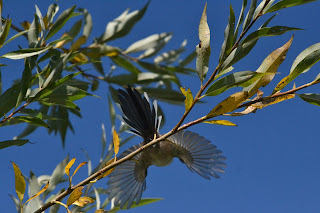The feeders are a hive of activity first thing in the morning, and its no wonder that the scene is noticed by the sharp eyes of a Sparrowhawk. The tits and finches suddenly vanish, and the doves clap their wings as they lumber away. All that is left is the hawk, alert and standing at the base of the tree trunk. She has something. Lifting off, she glides across to the back of the garden, alighting on the grass heap still in shadow. Green and yellow feathers blow away on the breeze- its a Greenfinch, a male. Up in the tall birch a magpie chatters- nervously watched through burnt orange eyes. The magpie chooses not to challenge the hawk, and she returns to her meal.
She's found a good hunting ground, and later on tries again- rushing at the fruit tree with the feeders in it- but this time without success. She perches among the cherry crabs, ignoring the scolding and taunting of the Blue Tits that hop around in front of her. They are defenceless if surprised, but once alerted to danger the small birds can use the dense cover as protection, and the hawk won't waste her energy.
Eventually she moves on, and with three or four quick flaps she reaches a pile of dead wood. The sun shines on her pale,barred breast, and, cover blown, she's off over the hedge.




















































